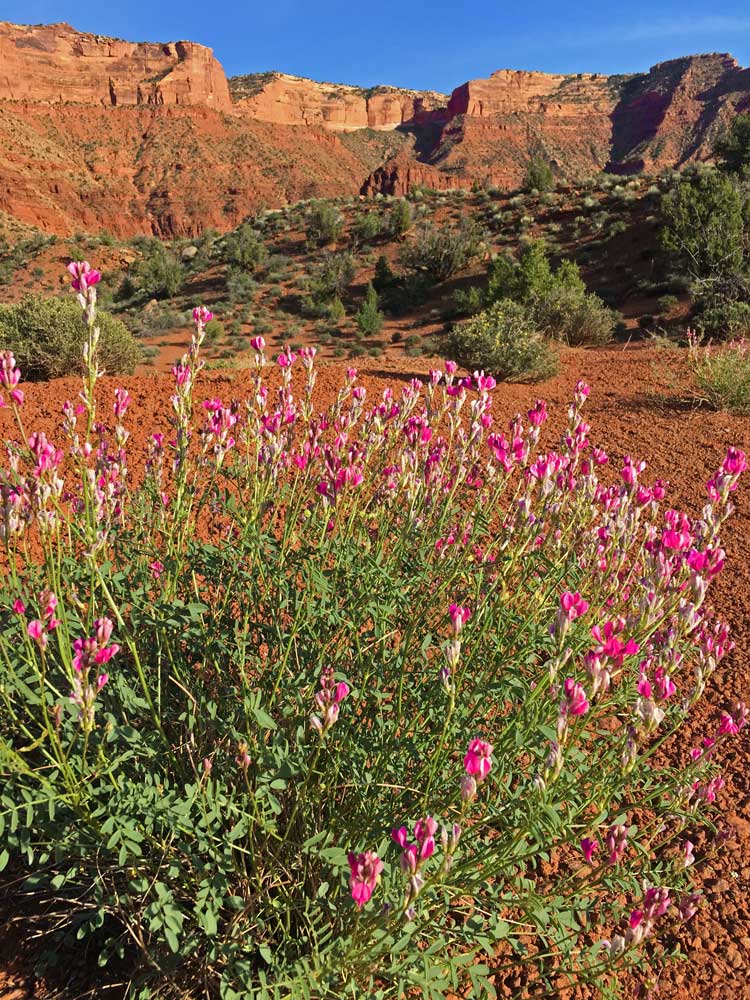It's tempting to view the high deserts of Utah and Colorado as a landscape empty of life, filled only with the fantastic geological rock formations that make this area so uniquely beautiful. But in truth, this region is full of life, and its subtlety is one of the most treasured qualities of this special place. In the springtime, it's the small pops of paintbrush red, prickly pear pink, penstemon magenta and cliffrose white that draw our attention. These blossoms help us understand that the desert is not just a giant sandbox, but rather a colorful landscape teeming with life.
Edward Abbey, an environmental pioneer, author, former Arches National Park ranger and inspiration to most Backroads leaders guiding trips in the canyon lands of the American Southwest, wrote:
"It seems to me that the strangeness and wonder of existence are emphasized here, in the desert, by the comparative sparsity of the flora and fauna: life not crowded upon life as in other places but scattered abroad in spareness and simplicity, with a generous gift of space for each herb and bush and tree, each stem of grass, so that the living organism stands out bold and brave and vivid against the lifeless sand and barren rock."
I'm currently exploring the high desert of Utah, home to Backroads' Arches & Canyonlands Walking & Hiking Tour that takes you on a journey through a region known for spires, buttes, canyons and pinnacles that have been etched into the giant geological layer cake that is the Colorado Plateau. There's a lot of desert here and a lot of petrified sand dunes that afford limitless adventuring opportunities. When you first lay your eyes upon the vast landscape, it may not seem like there is much to see other than the visual splendor of red rock and not much life other than the mountain bikers, hikers and other adventurers exploring its nooks and crannies. It takes time, patience and curious eyes to develop an appreciation for how the desert lives and how it thrives.
In the high desert we don't hear much other than the wind. We may see the singular raven, with its fluffy neckline blowing in the wind, carefully observing its surroundings. Animals out here blend into their surroundings more so than in other places. I recently hiked only feet away from a family of bighorn sheep that so seamlessly blended into the beige/grey rock behind them that we failed to notice them until, about a mile further down the trail, a lunch-eating first grader alerted us to their presence. His keen and curious young eyes helped our group locate these camera-shy creatures off in the distance.
We also encounter amazing flora that has cleverly and subtly adapted to life in this harsh environment. Here there are hundred-year-old biological soil crusts that keep the sand and plants rooted, funnel-shaped leaves that divert precious water toward the most vital sections of the plants, spikes and waxy leaf coatings that protect, cactus pads that retain water and plants that are able to turn a branch of themselves dormant depending on the water resources available at any given time. Every tiny leaf, spike or curious curly-cue you find in the high desert is designed that way for a purpose.
During the springtime, every new week stuns us with a different display of new blossoms. It's quite a sight but they don't stay for long. Each bursts individually, one little plant at a time in a sea of sand or even in a small crack. Though it may not be a bountiful garden display, it's each plant standing proudly on its own using its resources wisely, showing its 'feathers' and then quickly dispersing dormant seeds that will wait until next year and sufficient water to continue the life-cycle of it species. The thing is, even though we may not see much life there, the high desert is not as barren as it may seem. This is an ecosystem that is thriving in its own way, a way that's just more subtle than what we're used to in other climates. And this makes every natural discovery here meaningful and inspiring. So get out there, as deep into the desert as you can, opening your child-like eyes, getting close to the ground and seeing how much life you can spot out in this very much alive sandbox.















